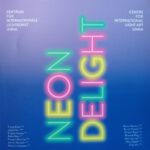Neon in Art Neon in der Kunst

‘Neons’ stand out from their surroundings on account of their high-impact presence. The specific way these tubes are manufactured allows them to be fashioned in an abundance of designs. For example, the materiality of glass means that an array of shapes is conceivable. In its heated state, the glass of the subsequently rigid light tube is flexible, which enables the representation of a straight or curved line of light, an abstract or figurative appearance, and lettering in print or handwriting. Words and phrases can be blown in one piece, or each letter is formed individually. Some artists use their own handwriting, while others choose not to do so. neon in art
Besides the broad spectrum of possible hues, neon tubes are very vividly coloured. Thus it is possible, depending on processing method, to overcome the glass’s physical limitation and produce the impression of immateriality, or alternatively to emphasize the material in its object-ness.
The versatility of neon systems is enhanced by the option of sequence-switching, which permits staggered illumination and hence the depiction of movements. neon in art
These properties of neon are the reasons behind why the neon tube united consumerism and aesthetics from the very beginning – notwithstanding its chiefly commercial use at first. As a result of neon’s non-industrial production method, away from prefabricated designs, the manufacture of expressive objects was thus achieved. Sonia Delaunay made use of this at an early stage, and had a commissioned work realized using neon. Neon tubes also gained appeal as components of architectonic details, for the accentuation of rooms, for instance.
In 1936 the Czech artist Zdeněk Pešánek incorporated neon tubes into his series of glass sculptures of male and female torsos, thereby introducing them into fine art. The neon tubes accentuated the external form of the contoured human bodies made of glass and simultaneously illuminated the sculpture’s interior. As the Second World War progressed the Nazis rendered more widespread use of neon in European art impossible. Works containing neon tubes as a material did not reappear until 1946: Gyula Kosice’s Estructura lumínica Madí 6 was a geometric arrangement mounted on wood that gleamed in blue light and was exhibited in Buenos Aires. Kosice was a co-founder of the artist’s group Madí.
neon in art
At the same time Lucio Fontana, likewise in Buenos Aires, founded the Academia Altamira and published the ‘Manifesto Blanco’, in which he expounded his theory of ‘spazialismo’. In the manifesto, in addition to a rejection of traditional materials he called for the abandonment of the smooth surface and two-dimensionality of the canvas. The call to devote oneself spatially was followed not only by his well-known slashed pictures, but also his neon drawings in space. In 1951, at the 9th Triennale in Milan, he drew Struttura al neon per la IX Triennale di Milano, a ceiling-hung structure of twisted lines made out of neon tubes. It was the first neon work not to rely on further materials.
Even though the first use of neon tubes in a clearly artistic context goes back to the 1930s, today the 1960s in particular can be characterized as influential for the material’s evolution in fine art. From today’s perspective, it would indeed have been highly surprising if the desire for change, which resulted in the use of various new materials, had not also brought the neon tube back into art.
neon in art
From the mid-1960s onwards, artists such as François Morellet, Keith Sonnier, Mario Merz, Maurizio Nannucci, Bruce Nauman, and Joseph Kosuth subsequently discovered the neon tube for themselves. They are the most famous protagonists of art using neon tubes to this day.
[…] […]
Not all artists work conceptually with words [in this way]: If one looks at the diverse array of other neon texts, it may seem that neon has not fully cast off its original function as a promotional message-bearer, even in art. No longer is it products that are advertised using neon, but thoughts. The question why these thoughts are not put onto paper in the traditional manner can be answered with the way the material makes its impact. Especially in the form of words and phrases, the charisma of neon tubes leaves behind an irreal impression. Like a prophecy, they remain aloof from mundanity. Through them, profound sentiments and abstract thoughts become easier to convey, and the risk of dismissing what is written as meaningless and trivial is allayed. However, verbal utterings in the form of text also always have a visual shape, equally on paper. Not only can they be read, they can also be looked at. This is of particular significance in the case of writings made of neon, since they abandon the two-dimensionality habitual to texts. The relationship between form and content is reconceived, and therefore these words, in their plasticity, always express a visual poesy too.
Neon texts are statements – they are hard to ignore. […] […]
